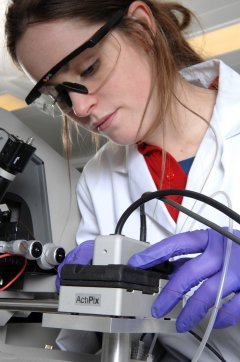Paraytec Ltd. has announced that its ActiPix D100 system is being used by the Biosystems Research Group at Sandia National Laboratories (Livermore, CA, USA) to develop a capillary electrophoresis - based monitoring system for the "Explosive Destruction System" part of the U.S Chemical Demilitarisation program.

"Explosive Destruction System" or EDS is a transportable treatment system designed to destroy explosively configured World War I and World War II-era munitions. The EDS can be used to detonate chemical munitions safely and neutralise the associated chemical agents without venting to atmosphere. For real-time monitoring of the degradation of munitions, Sandia is building an automated microfluidic platform that extracts and processes a small sample for analysis by sensitive electrophoretic separations in a capillary. At the heart of the platform is Paraytec's ActiPix D100 UV area imaging detector. Initially chosen for its compact size, the detector has been successfully integrated into the automated monitoring system.
"We are happy with the performance of the detector and ease in which we could integrate it into our system, said Dr. Kamlesh Patel, Ph.D, team leader for systems integration for the EDS monitoring system. "The small footprint is critical in our microsystem. Another key feature that makes the ActiPix detector useful is its ability to actively monitor two (or more) detection points simultaneously. In our system we use one channel to detect the sample eluting from an extraction bed, which triggers an injection valve, and a second channel for the detection of the analytes in the separation." This approach would be nearly impossible with other UV detectors in the market."
Paraytec's multi-award winning product, the ActiPix D100, is the world's first quantitative UV area imaging system. As well as providing superior performance over existing micro and nano flow detectors the patented ActiPix opens up intriguing new possibilities never before possible using conventional detectors.
Applications for the company's patented ActiPix technology can be broadly classified into two types, area imaging or capillary based. Area imaging applications include real time study of diffusion processes, in-line quantification and sizing of biopharmaceuticals, dissolution / solubility testing and membrane transport studies. Capillary based applications include use of the ActiPix D100 as a sensitive and selective detector for multiplexed capillary electrophoresis (CE), nano-liquid chromatography (nanoLC) and capillary LC experiments.
Paraytec Ltd is a scientific instrument company based in York, UK, designing, developing and manufacturing innovative detectors. Paraytec was established in January 2005 as a spin-out from the Chemistry Department at the University of York, UK. Winner of the prestigious PittCon Editors Silver Award and an R&D 100 Award in 2007, the ActiPix D100 has achieved widespread recognition as a novel analytical instrument delivering applications advances.
For further information please contact Paraytec Ltd. on +44-1904-526270 or email [email protected]